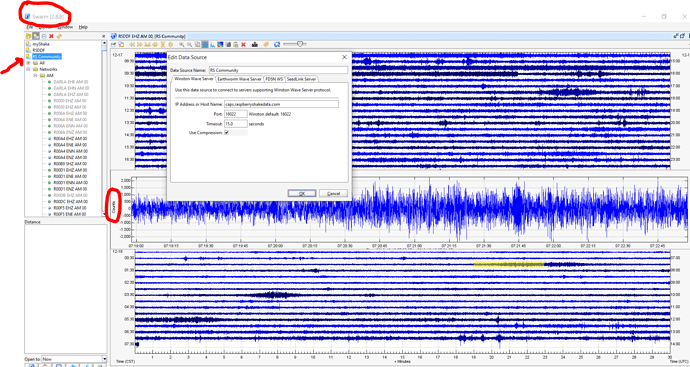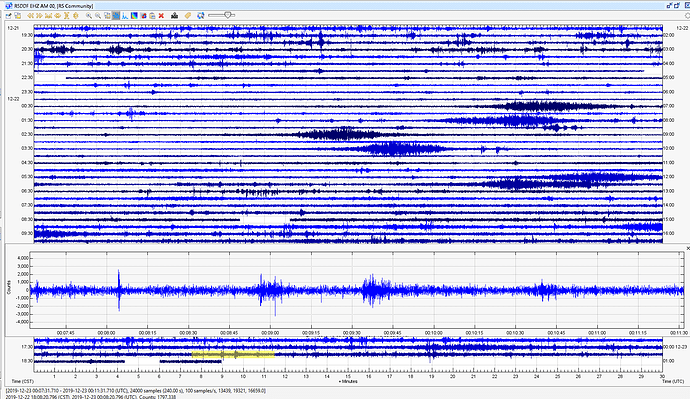Good Morning Shakers, I am not coding savvy, and have little time to learn at the moment. I am viewing my RS1D data in the SWARM application, and my new RS1D is only displaying “counts” instead of “m/s”, as it used to do, when I extract a seismogram from the helicorder - see pictures. I referenced the RS manual and an older SWARM manual, and I found instructions to accomplish this by clicking “ON” “Use Calibrations” in the Wave View Settings dialog box (again, see photos). I have checked this feature to ON, and still no luck… help? I am currently seeing my extracted seismograms in counts, but I wish to see them in m/s using SWARM - thoughts? I really appreciate any help, TIA!
I think this was a bug in a recent version of SWARM. The latest version 3.0.0 does not have this bug.
Ty, I will check out version 3.0.0 - I have been avoiding it b/c it has tits own known bugs such as not being able to see beyond so many days in the helicorder view.
My version of 3.0.0 doesn’t have such a bug.
I can go back as far as like.
Or do you mean the window shows only a day of data?
Note that the calibrations are requested from the server so this feature will only work when you are using Swarm to connect to the Raspberry Shake Community Server (as described here: http://manual.raspberryshake.org/traces.html#swarm) and not when you are connecting directly to your Shake.
branden
Hi Branden, correct, I am using SWARM 2.8.8 and I am connected to the RS as you show network
Here is a screenshot of the settings and also the extracted seismogram displaying in “counts”. Second photo is a different station under the same database but it displays in m/s. It appears the problem is with my station R5DDF.
Confirmed. The problem is with this station. @ivor - can you look into this?
branden
hello,
looking at the response file for this station, R5DDF, the sensor was defined as unknown for the following period:
<start>2019-12-04T12:30:12.388Z</start>
<end>2019-12-17T14:27:26.409Z</end>
and was then changed to use the Shake sensor from:
<start>2019-12-17T14:27:26.41Z</start>
without knowing the internals of how SWARM might detect and handle this change on the same day, i suspect it is not accurately applying different sensor definitions over time within the display.
if the sensor change is true, then SWARM will need to be enhanced to handle this. if the sensor change is not an accurate reflection of what happened, the response file should be updated to remove the false description of the sensor.
cheers,
richard
Hi Richard, you are correct. On 12/17/2019 I went to the front end userface (rs local or the Config screen) and went to Actions >> Settings >> DId you Receive a Geophone… and changed to “Yes”. I have a RS1D, is this the correct setting? I was trying to troubleshoot this problem. Thanks for the troubleshooting help…Kristi
well, there are two questions here:
- did you switch out geophones, using first your own then swapping it with the geophone provided by us? OR
- did this unit only use the geophone provided by us where you had inadvertantly answered the geophone question as NO, when it should have been YES?
if the 2nd, let me know and i will update the DB record by hand to remove the incorrect geophone specification.
cheers,
richard
Option 2 occurred, sorry 'bout that!
the response file has been updated, please try again, your y-axis label problem in swarm should be resolved.
cheers,
richard
I attempted to view Station R5DDF again at 1:10 UTC 12/23/2019… still displays as
“Counts”, see picture
hi kristi,
as you may know, swarm is written and maintained by the USGS, not the Shake group. looking at your issue, it is unclear to anyone here what could be going on and why your particular unit is not displaying the conversion to real units of velocity.
we have tried to locate debug message settings, etc. in swarm but cannot find anything useful. we suggest you contact the swarm group directly and ask them if there are ways to turn on debug messaging (or can add it), so that this sort of problem can be analyzed so that a solution can be identified.
as it is, when there is no information as to why something is behaving incorrectly, identifying the proper solution is usually impossible.
regards,
richard
p.s. looking at various stations in swarm of the AM network, i see a mix of successful display units (converted properly) and unsuccessful (only displays counts). it is totally not obvious why some are working while some aren’t.
Ty Richard! I will contact SWARM tech support in the New Year and see if any progress can be made. I am very disappointed that the SWARM online manual does not address this issue.





